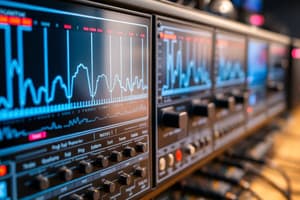Podcast
Questions and Answers
What does the Nyquist Sampling Theorem help avoid in communication systems?
What does the Nyquist Sampling Theorem help avoid in communication systems?
- Noise interference
- Aliasing (correct)
- Signal distortion
- Signal loss
In the modulation process, what type of function does a sinusoid typically represent?
In the modulation process, what type of function does a sinusoid typically represent?
- A random function
- An unbounded function
- A bounded function (correct)
- A digital function
What is the primary role of a demodulator in communication systems?
What is the primary role of a demodulator in communication systems?
- To sample the incoming data
- To extract the original signal (correct)
- To amplify signals
- To encrypt data
Which term refers to the transformation of energy in communication systems?
Which term refers to the transformation of energy in communication systems?
What is indicated by the term 'singularity' in the context of functions?
What is indicated by the term 'singularity' in the context of functions?
Which mathematical operation can be represented by the symbol 'or' in logical expressions?
Which mathematical operation can be represented by the symbol 'or' in logical expressions?
What does the term 'Energy' typically relate to in a scientific context?
What does the term 'Energy' typically relate to in a scientific context?
What is the result of applying the quadratic function represented in the equation i.e., $4x^{2} + 2$?
What is the result of applying the quadratic function represented in the equation i.e., $4x^{2} + 2$?
In the context of power, what is typically defined as the rate at which work is done?
In the context of power, what is typically defined as the rate at which work is done?
Which of the following corresponds to the symbol for energy in physics?
Which of the following corresponds to the symbol for energy in physics?
What does the notation { 3 2,1 } represent in the context of signals?
What does the notation { 3 2,1 } represent in the context of signals?
In the given content, how is internal noise represented?
In the given content, how is internal noise represented?
What does the term 'align for shifting' suggest in noise analysis?
What does the term 'align for shifting' suggest in noise analysis?
Which sequence indicates a configuration for external noise?
Which sequence indicates a configuration for external noise?
How is the external noise described in relation to the given sets?
How is the external noise described in relation to the given sets?
What directly causes ionization in the ionosphere?
What directly causes ionization in the ionosphere?
Which statement accurately describes the D Layer of the ionosphere?
Which statement accurately describes the D Layer of the ionosphere?
What phenomenon occurs when radio wave signals follow the curvature of the Earth?
What phenomenon occurs when radio wave signals follow the curvature of the Earth?
What does the E Layer, also known as the Kennelly-Heaviside Layer, primarily aid in?
What does the E Layer, also known as the Kennelly-Heaviside Layer, primarily aid in?
Which layer of the atmosphere is the lowest and has the least impact on high-frequency communication?
Which layer of the atmosphere is the lowest and has the least impact on high-frequency communication?
What happens to radio waves in the D Layer of the ionosphere?
What happens to radio waves in the D Layer of the ionosphere?
How does tropospheric scattering affect radio wave propagation?
How does tropospheric scattering affect radio wave propagation?
What primarily influences auroral activity in the E Layer?
What primarily influences auroral activity in the E Layer?
Which type of wave is primarily responsible for initiating ionization in the ionosphere?
Which type of wave is primarily responsible for initiating ionization in the ionosphere?
Which of the following layers of the ionosphere is least ionized?
Which of the following layers of the ionosphere is least ionized?
What characterizes a linear time-invariant system?
What characterizes a linear time-invariant system?
Which statement is true about periodic and aperiodic functions?
Which statement is true about periodic and aperiodic functions?
Which property is representative of a homogeneous system?
Which property is representative of a homogeneous system?
Which function is recognized as a representation of linearity?
Which function is recognized as a representation of linearity?
Which of the following describes an additive system?
Which of the following describes an additive system?
What can be concluded about all trigonometric functions?
What can be concluded about all trigonometric functions?
Which of the following represents a characteristic of discrete functions?
Which of the following represents a characteristic of discrete functions?
Which formula best exemplifies a homogeneous transformation?
Which formula best exemplifies a homogeneous transformation?
In the context of systems, what does 'additive' imply?
In the context of systems, what does 'additive' imply?
What is a common feature of linear systems?
What is a common feature of linear systems?
Flashcards are hidden until you start studying
Study Notes
Signals and Noise
- Sinusoid is represented by a mathematical function that can be used for modulation and keying
- Nyquist Sampling Theorem is a principle that helps to avoid aliasing and extract useful information from signals. Sampling rate should be at least twice the maximum frequency of the signal
- Systems: physical devices performing operations on signals
- Linear Time-Invariant (LTI) Systems:
- Homogeneous: If the input is multiplied by a constant, the output is also multiplied by the same constant
- Additive: The output of the system is the sum of the outputs for individual inputs
- Periodic and Aperiodic Functions:
- Periodic Functions: repeat themselves over a fixed interval
- Aperiodic Functions: do not have a repeating pattern
- Energy and Power:
- Energy signals: have finite energy over an infinite interval
- Power signal: have finite power over an infinite interval
- Internal and External Noise:
- External Noise: Interference from outside sources
- Internal Noise: Noise generated within the system
- Radio Horizon: The distance from the radio transmitter to the point signal can reach
- Ionization Occurs when high energy ultraviolet light from the sun enters the ionosphere and knocks electrons free from atoms in the gas
- D- Layer: The lowest layer of the ionosphere, least ionized, absorbs radio wave signals
- E- Layer: Also called Kennelly-Heaviside Layer; important for medium frequency propagation (MF) and auroral activity
- Ducting: Radio signals follow the curvature of the earth, often due to temperature and density variations in the atmosphere
Studying That Suits You
Use AI to generate personalized quizzes and flashcards to suit your learning preferences.




